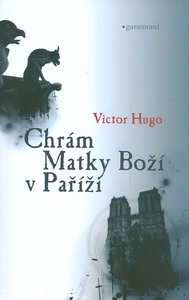You need to sign in or sign up before continuing.
Take a photo of a barcode or cover
English review below.
« Drame et épopée, pittoresque mais poétique, réel mais idéal, vrai mais grand ». Tel est l’art du roman que Victor Hugo a voulu créer. Il ne faut pas chercher dans Notre Dame de Paris que le drame, que le roman. Le plaisir de démêler autre chose que le roman, la pensée esthétique, historique, et philosophique qui se cache derrière le roman, s’avère être le plaisir le plus délicieux.
Il m’arrive de sentir dès la première phrase d’un roman que je serais en présence d’une grande œuvre. J’ai de suite senti cet élan de joie et d’excitation que je cherche constamment dans mes lectures.
J’ai adoré lire sur Paris au XVe siècle qui prenait vie à chaque nouvelle ligne. C’était comme si je marchais dans les rues de Paris que j’ai apprises à connaître, mais plus de 500 ans plus tôt. Le drame, l’histoire, les personnages, culminent pour peindre ce tableau de vie parisienne qui restera longtemps gravé dans mon esprit.
La beauté lyrique de certains passages me laissait enchantée et m’a offerte un plaisir incomparable. Ce plaisir suffirait-il pour que je me lance enfin dans la lecture des Misérables resté longtemps non-lu sur mon étagère ?
.
"A novel which is at once drama and epic, picturesque but poetic, real but ideal, true but great". This is the art of the novel that Victor Hugo wanted to create. The novel that elevates the pleasure of unraveling what is hidden behind the plot: the aesthetic, historical and philosophical thoughts.
From the first sentence, I immediately felt a surge of joy and excitement that I constantly look for in my readings. I loved reading about Paris in the 15th century. It was as if I was walking the streets of Paris that I have come to know, but more than 500 years earlier. The drama, the story, the characters, culminate in painting this picture of Parisian life that will remain etched in my mind.
The beauty of certain passages left me enchanted. The lyrical prose has given me incomparable pleasure. Would this pleasure be enough for me to finally start reading Les Misérables that has been left unread on my shelf for a long time? Or is it too heavy for such a time?
« Drame et épopée, pittoresque mais poétique, réel mais idéal, vrai mais grand ». Tel est l’art du roman que Victor Hugo a voulu créer. Il ne faut pas chercher dans Notre Dame de Paris que le drame, que le roman. Le plaisir de démêler autre chose que le roman, la pensée esthétique, historique, et philosophique qui se cache derrière le roman, s’avère être le plaisir le plus délicieux.
Il m’arrive de sentir dès la première phrase d’un roman que je serais en présence d’une grande œuvre. J’ai de suite senti cet élan de joie et d’excitation que je cherche constamment dans mes lectures.
J’ai adoré lire sur Paris au XVe siècle qui prenait vie à chaque nouvelle ligne. C’était comme si je marchais dans les rues de Paris que j’ai apprises à connaître, mais plus de 500 ans plus tôt. Le drame, l’histoire, les personnages, culminent pour peindre ce tableau de vie parisienne qui restera longtemps gravé dans mon esprit.
La beauté lyrique de certains passages me laissait enchantée et m’a offerte un plaisir incomparable. Ce plaisir suffirait-il pour que je me lance enfin dans la lecture des Misérables resté longtemps non-lu sur mon étagère ?
.
"A novel which is at once drama and epic, picturesque but poetic, real but ideal, true but great". This is the art of the novel that Victor Hugo wanted to create. The novel that elevates the pleasure of unraveling what is hidden behind the plot: the aesthetic, historical and philosophical thoughts.
From the first sentence, I immediately felt a surge of joy and excitement that I constantly look for in my readings. I loved reading about Paris in the 15th century. It was as if I was walking the streets of Paris that I have come to know, but more than 500 years earlier. The drama, the story, the characters, culminate in painting this picture of Parisian life that will remain etched in my mind.
The beauty of certain passages left me enchanted. The lyrical prose has given me incomparable pleasure. Would this pleasure be enough for me to finally start reading Les Misérables that has been left unread on my shelf for a long time? Or is it too heavy for such a time?
Very humorous in parts, very depressing in others. A fascinating character study. Thought-provoking message about the longevity/centrality of historical buildings. Should have either been named for Esmeralda or the Notre Dame itself (as Hugo originally intended).
Was this a just fairy tale? I mean a darker fairy tale, where the frog didn’t get kissed, and instead ran away with the goat? (That’s a little of a spoiler). No, seriously, Hugo put a lot of time into researching this Paris of 1482, and this Cathedral, but he held off writing it until time became desperate, this according to Andre Maurois in the afterword. Then, he spent weeks locked in a room, wearing a head-to-toe sweater that he couldn’t leave the house in, and crunched out the actual text. So, there is a lot of Hugo’s outsized ego here, in all its, well, charm maybe. Actually he had a lot of fun with the text, which is full of expansive humor, long-winded ideas only Hugo appreciate, and a complete panoramic of Paris from the top of the Cathedral, recreated from his research and likely freely filled-in with details he didn’t know or wanted; in any case, the medieval city and this building are both very much there.
I read this with a group on Litsy over 8 weeks, in separate short burst with lots of in-app discussion between. The timing was in response to the tragic fire this past May. It really felt light read for such a famous classic. But then these characters are embedded in my head. I now feel I know Quasimodo and his keeper, the dark sorcerer archdeacon Claude Frollo of the Notre-Dame cathedral; Esmeralda and her anti-hero, the penniless philosopher Pierre Gringoire, and few other characters too, particularly Esmeralda's remarkable little goat, Djali.

My take is that this feels like eastern fairy tale, something maybe out of 1001 Nights, that was transported to medieval Paris, and then wrapped in light philosophizing lessons of sorts on love, beauty, corruption, mobs, fate, bad kings and fatally flawed presumed-guilty-driven legal systems. (Here justice isn't just blind, but also deaf.) Perhaps he might have had a recent failed revolution in mind, and a disheartening restoration. Maurois thinks it's a dark work and certainly the end is darker than a reader who doesn't know might expect. But the humor and fun touches are mostly what I have mind when I think about it.
While I did enjoy reading and discussing this, the book never really wowed me. I gave it 3.5 stars (rounded down here on GR)
-----------------------------------------------
30. The Hunchback of Notre Dame by Victor Hugo
published: 1831
translated 1965 from French by Walter J. Cobb
afterword 1965 by Andre Maurois, translated from French by Phyllis La Farge
format: 502-page Signet Classic paperback
acquired: from my childhood
read: May 5 – Jun 29
time reading: 21 hr 28 min, 2.6 min/page
rating: 3½
-----------------------------------------------

Paris sometime before the fire. (The image is from an article on the fire with some kind of cool panoramic visuals, here: https://www.abc.net.au/news/2019-04-18/notre-dame-walk-through/11024512 )
I read this with a group on Litsy over 8 weeks, in separate short burst with lots of in-app discussion between. The timing was in response to the tragic fire this past May. It really felt light read for such a famous classic. But then these characters are embedded in my head. I now feel I know Quasimodo and his keeper, the dark sorcerer archdeacon Claude Frollo of the Notre-Dame cathedral; Esmeralda and her anti-hero, the penniless philosopher Pierre Gringoire, and few other characters too, particularly Esmeralda's remarkable little goat, Djali.

My take is that this feels like eastern fairy tale, something maybe out of 1001 Nights, that was transported to medieval Paris, and then wrapped in light philosophizing lessons of sorts on love, beauty, corruption, mobs, fate, bad kings and fatally flawed presumed-guilty-driven legal systems. (Here justice isn't just blind, but also deaf.) Perhaps he might have had a recent failed revolution in mind, and a disheartening restoration. Maurois thinks it's a dark work and certainly the end is darker than a reader who doesn't know might expect. But the humor and fun touches are mostly what I have mind when I think about it.
While I did enjoy reading and discussing this, the book never really wowed me. I gave it 3.5 stars (rounded down here on GR)
-----------------------------------------------
30. The Hunchback of Notre Dame by Victor Hugo
published: 1831
translated 1965 from French by Walter J. Cobb
afterword 1965 by Andre Maurois, translated from French by Phyllis La Farge
format: 502-page Signet Classic paperback
acquired: from my childhood
read: May 5 – Jun 29
time reading: 21 hr 28 min, 2.6 min/page
rating: 3½
-----------------------------------------------

Paris sometime before the fire. (The image is from an article on the fire with some kind of cool panoramic visuals, here: https://www.abc.net.au/news/2019-04-18/notre-dame-walk-through/11024512 )
Sommige stukken zijn simpelweg niet door te komen en andere stukken lezen als een trein. De volledig beschrijvende manier laat je denken dat het verhaal aan je verteld word, je loopt absoluut door Parijs heen en je voelt de connectie tussen Quasimodo en die prachtige Notre Dame. Het begin is een bittere pil, maar gelukkig volgen de betere stukken elkaar vaak op. Misschien iets teveel personages, het beschrijvende van de tijd te overdadig. Niet het boek wat ik je per direct zou aanraden, maar al met al geen slechte klassieker.
Capolavoro! Ambientato alla fine del 400 ha la cattedrale al centro della narrazione. Hugo descrive nei minimi particolari la struttura della stessa risultando certe volte prolisso. E' un opera immortale cosi come gli intrighi e le vicende narrate dall'autore. Non mancano neanche i momenti di pura poesia che ho amato alla follia. Mi sono innamorato di Esmeralda, ho vissuto la disperazione di Quasimodo e ho pianto alla fine del romanzo (solo poche volte succede).
dark
slow-paced
Plot or Character Driven:
Plot
Strong character development:
Complicated
Loveable characters:
Yes
Diverse cast of characters:
No
Flaws of characters a main focus:
Yes
Good book, but Hugo's educational tangents are really not germane to the plot. Not even a little. Then when he gets into the plot, I feel like he's a bit light on action. Show me, Hugo. Show me what's going on. Don't just tell me. These were the thoughts going through my mind the whole book - I felt a bit like an intro to storytelling teacher working on the basics. Yet, this is one of the most famous novels of all time, written by one of the most accomplished authors of all time. It's always fun to imagine what books like this would look like if they were published in the 21st century. It would have more action, more psychological insight, and probably a cleaner POV (the 19th-century omniscient narrator who occasionally talks to the reader just doesn't fly these days). And yet, after completing the book, I somehow still feel that I experienced the suffering of Esmeralda and the tragic confusion and sadness of Quasimodo. I'd recommend this.
challenging
emotional
reflective
slow-paced
Plot or Character Driven:
A mix
Strong character development:
No
Loveable characters:
Complicated
Diverse cast of characters:
N/A
Flaws of characters a main focus:
Complicated
challenging
dark
mysterious
sad
tense
slow-paced
Plot or Character Driven:
A mix
Strong character development:
Yes
Loveable characters:
No
Diverse cast of characters:
Yes
Flaws of characters a main focus:
Complicated






